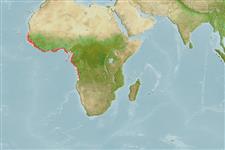Environment: milieu / climate zone / depth range / distribution range
Ökologie
seewasser demersal; tiefenbereich 80 - 300 m (Ref. 3589). Tropical; 17°N - 13°S, 19°W - 15°E (Ref. 5222)
Eastern Atlantic: Mauritania (Ref. 5377) and Senegal to southern Angola.
Size / Gewicht / Alter
Maturity: Lm ? range ? - ? cm
Max length : 140 cm TL Männchen/unbestimmt; (Ref. 5377); common length : 50.0 cm TL Männchen/unbestimmt; (Ref. 26999)
Rückenflossenstacheln (insgesamt) : 11; Rückenflossenweichstrahlen (insgesamt) : 16; Afterflossenstacheln: 3; Afterflossenweichstrahlen: 8. Distinguished by the following characteristics: brownish head and body; 3-4 broad oblique bars on the dorsal part of the body and another on the dorsal half of the peduncle; 2 narrow faint dark bands extending posteriorly from the lower half of the eye; presence of dark moustache streak, not extending past the rear end on maxilla; body depth less than head length, depth contained 2.9-3.2 times in SL; head length 2.5-2.7 times in standard length; flat or slightly convex interorbital area; angular preopercle, 3-4 enlarged serrae at the angle, lowermost directed ventrally; serrate interopercle and subopercle; well developed middle and lower opercular spines, upper spine not apparent; approximately straight upper edge of operculum; maxilla reaches vertical at rear edge of eye; maxilla naked or with few minute scales dorsally; 2 rows of teeth on midlateral part of lower jaw; posterior nostril about twice the size of anterior nostril (Ref. 89707).
Reported to occur from a variety of habitats (rock, mud and sand). The adults live in relatively deeper waters (Ref. 5377). Little is known about its biology.
Life cycle and mating behavior
Geschlechtsreife | Fortpflanzung | Ablaichen | Eier | Fecundity | Larven
Heemstra, P.C. and J.E. Randall, 1993. FAO Species Catalogue. Vol. 16. Groupers of the world (family Serranidae, subfamily Epinephelinae). An annotated and illustrated catalogue of the grouper, rockcod, hind, coral grouper and lyretail species known to date. Rome: FAO. FAO Fish. Synop. 125(16):382 p. (Ref. 5222)
IUCN Rote Liste Status (Ref. 130435: Version 2024-1)
Bedrohung für Menschen
Harmless
Nutzung durch Menschen
Fischereien: kleinfischerei
Tools
Can't connect to MySQL database fbquizv2. Errorcode: Too many connections
